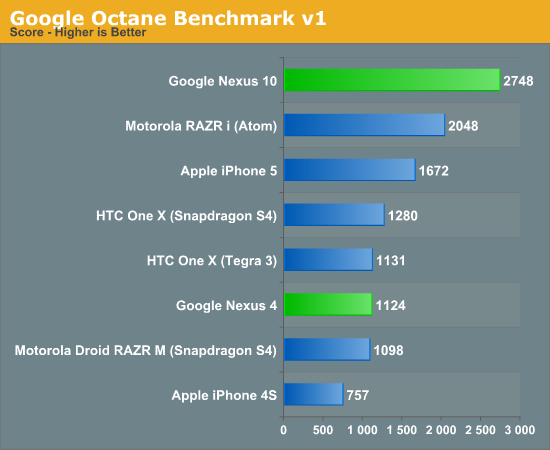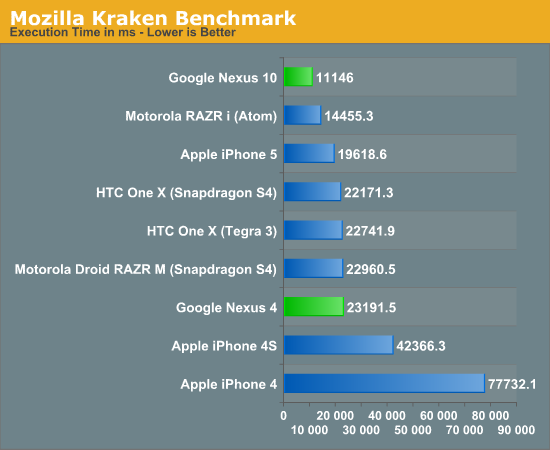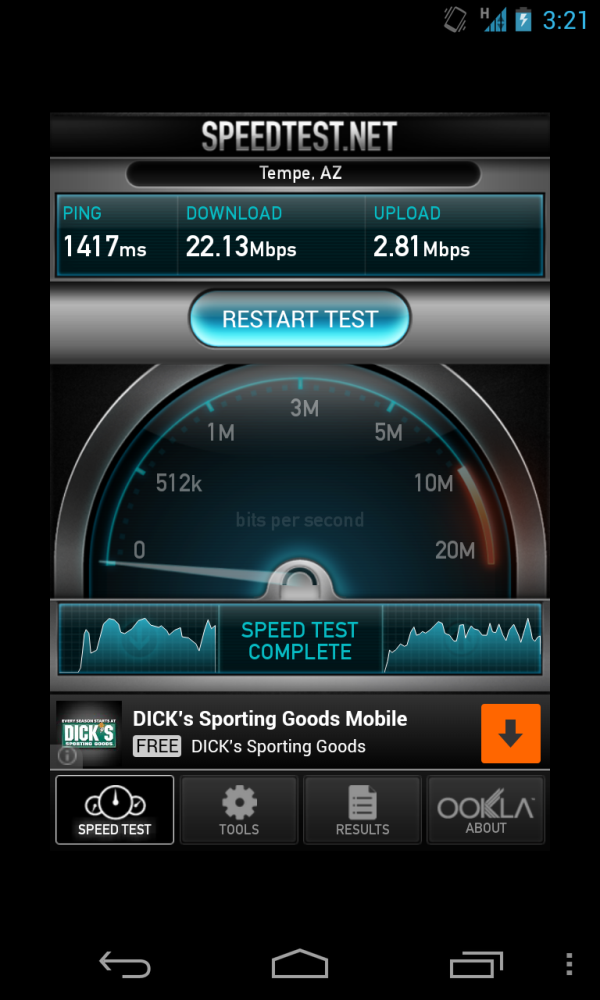Google Nexus 4 and Nexus 10 Performance Preview
by Anand Lal Shimpi & Brian Klug on November 2, 2012 11:00 AM ESTEarlier this week Google announced two new flagship Nexus devices: the Nexus 4 smartphone and the Nexus 10 tablet. We received review samples of both earlier this week, and while we're hard at work at full reviews of the devices we couldn't help but share all of the test data we've been able to amass at this point.
For those who aren't familiar with it, the Nexus 4 features Qualcomm's Snapdragon S4 Pro SoC - a quad-core 28nm Krait CPU with Qualcomm's next-generation Adreno 320 GPU. The combination proved quite formidable in the MDP/T we tested, as well as LG's recently announced Optimus G. The SoC drives a 4.7-inch 1280 x 768 IPS display and is paired with 2GB of LPDDR2 memory. The Nexus 4 ships unlocked with 8GB of NAND for $299 without a contract ($349 for the 16GB version). Pair that with DC-HSPA+ support and you get an absolute killer smartphone for use on T-Mobile: no contracts, very low monthly fees, and compelling cellular performance:
Brian will talk more about the combination in his full review, but rest assured that the lack of LTE is workable depending on T-Mobile coverage where you live/travel to.
The Nexus 10 also boasts a brand new SoC: Samsung's Exynos 5 Dual. The Exynos 5 Dual features two ARM Cortex A15 cores running at 1.7GHz as well as ARM's own Mali-T604 GPU. This happens to be the exact same platform used in the new Chromebook, just running Android. The Nexus 10 features a 10.1-inch 2560 x 1600 display, giving it the same resolution as the 13-inch MacBook Pro with Retina Display - but in an even smaller form factor. Google is also aggressive on Nexus 10 pricing: the 16GB WiFi-only tablet sells for $399, with the 32GB version going for $499.
Both Nexus devices run Android 4.2 and are guaranteed to be the first devices to be updated to upcoming Android revisions for the foreseeable future (it's the power of Nexus).
We haven't had a ton of time to test the devices and put this together so you're going to see combined performance charts throughout the rest of this article.
CPU Performance
The big story when it comes to CPU performance is a look at how the Cortex A15s perform under Android. Unfortunately we're still left with mostly browser based benchmarks to measure CPU performance, which actually highlights a major issue in our testing: Android V8 optimization doesn't seem to be anywhere near as good as it is under Chrome OS or Windows. As a result, all of the Nexus 10 performance scores end up slower than the new Chromebook - despite using the same SoC and running Chrome on both platforms. It's also possible that the Exynos 5 Dual in the Chromebook is allowed to burn a bit more power, translating to better performance, but either way the solution here in the Nexus 10 doesn't look as good across the board.

SunSpider performance is good, but not significantly better than Qualcomm's Krait based Snapdragon S4. Both the iPhone 5 and RAZR i are able to outperform the Nexus 10. The S4 Pro based Nexus 4 tends to be in line with other S4 based devices - SunSpider doesn't really give much credit to the extra 2 cores.

BrowserMark puts the Nexus 10 behind many platforms that should be faster, I'm even wondering here if there's some hard partitioning of memory bandwidth between the CPU and GPU to drive the 2560 x 1600 display that's simply choking the CPU here.
The Nexus 4 does ok, but again there seem to be some V8 optimization issues at work here under Android 4.2. At 1.5GHz it should deliver at least the performance of the dual-core Snapdragon S4 solutions.

Octane is the first test where the Cortex A15s are really able to flex their muscle - the Exynos 5 Dual based Nexus 10 manages to outperform the RAZR i by 34%, and compared to the A6/Swift based iPhone 5 the advantage grows to 64%.
The Nexus 4 performs about in line with other Snapdragon S4 based devices, although once again the extra 2 cores don't seem to be doing much for it here at all.

Kraken also paints the Cortex A15 based Nexus 10 in a good light: there's a 30% advantage over the RAZR i and a 76% advantage over the iPhone 5. These numbers will shrink a bit compared to other tablets, but not by much. The Nexus 4, once again, ends up performing similarly to dual-core Snapdragon S4 based devices.
Overall, the Nexus 10 results show us some real promise for what we can expect from ARM Cortex A15 based SoCs. The potential upside to this new architecture is huge.

















244 Comments
View All Comments
A5 - Friday, November 2, 2012 - link
You know there's a second page, right?pattycake0147 - Friday, November 2, 2012 - link
Will we be seeing tablets in Bench anytime soon?chrone - Friday, November 2, 2012 - link
looking forward to the storage performance review. :)LaMpiR - Friday, November 2, 2012 - link
I was against buying an iPhone but it kicks ass in every benchmark. Like the Nexus 4, will be my next phone.Ananke - Friday, November 2, 2012 - link
So another tablet without SD card, USB and HDMI out....this is like Ferrari engine in Fiat Uno body :) pathetic.tayb - Friday, November 2, 2012 - link
The CPU benchmarks are crap. Where is the iPad 3? Where is the iPad 4? Why is the Nexus 10 being compared to a bunch of smart phones instead of a bunch of tablets?Klug4Pres - Friday, November 2, 2012 - link
"All Android tests use Chrome and 5GHz WiFi unless otherwise listed."Nexus 4 doesn't support 5 GHz WiFi, but you have not listed this.
Klug4Pres - Friday, November 2, 2012 - link
Actually, apparently Brian tweeted:"Browsed through the Nexus 4 FCC reports on the flight, interestingly enough 5 GHz wifi is just 20HT (no 40 MHz channels)"
... so I am probably wrong - but then, surely you wouldn't test with 5 GHz on narrow channels?
noblemo - Friday, November 2, 2012 - link
The FCC tests were performed using 20 MHz channels. I am not sure whether the Nexus 4 supports 40 MHz channel width. It uses a single antenna for all Wi-Fi and Bluetooth. If I understand correctly, devices that support wide band Wi-Fi use two antennas simultaneously.More information regarding the FCC 5GHz Wi-FI testing is contained on pages 33-34 in the file "SAR report part 1."
https://apps.fcc.gov/oetcf/eas/reports/ViewExhibit...
firesyde424 - Friday, November 2, 2012 - link
I get the general idea that, for whatever reason, it's fairly difficult to get anything more than a ballpark idea about relative speed when comparing smartphones. For instance, most of AT's benchmarks show the US version of the HTC One X as faster than the international version. Having had both of them sitting next to each other, my benchmarks don't bear that out. My benchmarks show the Internation version as considerably faster in cpu tests and in gpu tests, the two were roughly even.Even in this article, my Octane score for the Int S3 and Int HOX were 3-400 points higher than AT has listed here. I'm not saying that AT's scores are invalid. My gripe is that there doesn't seem to be a lot of consistency in the mobile computing space yet. Hopefully that changes with further generations of smartphones.